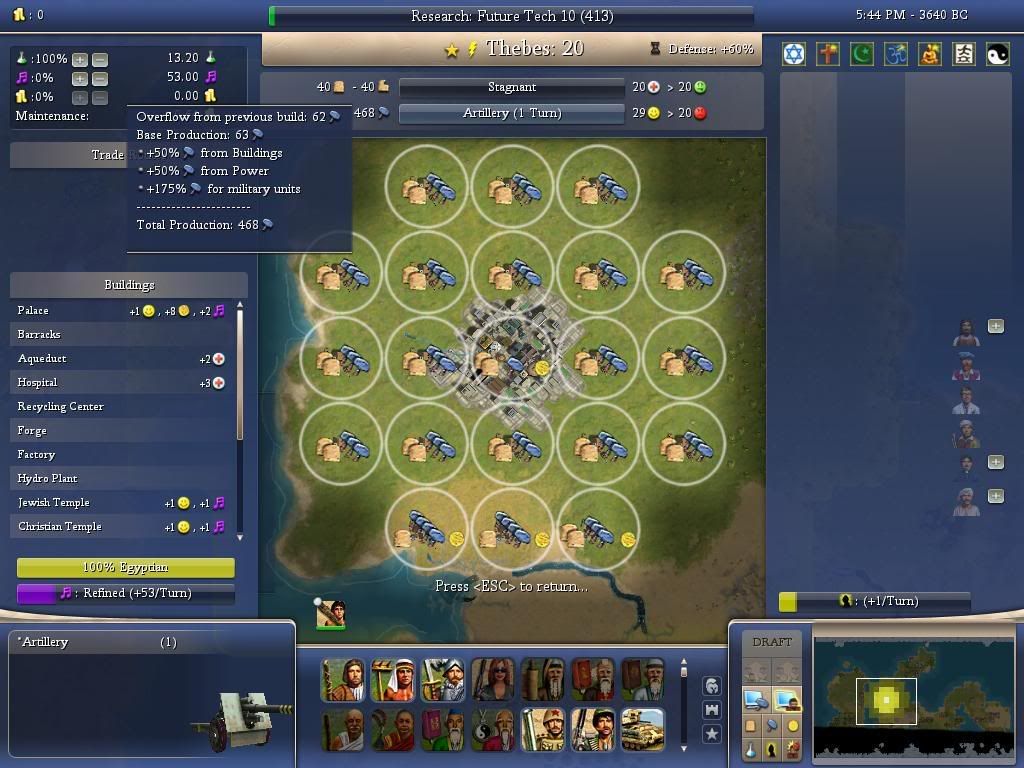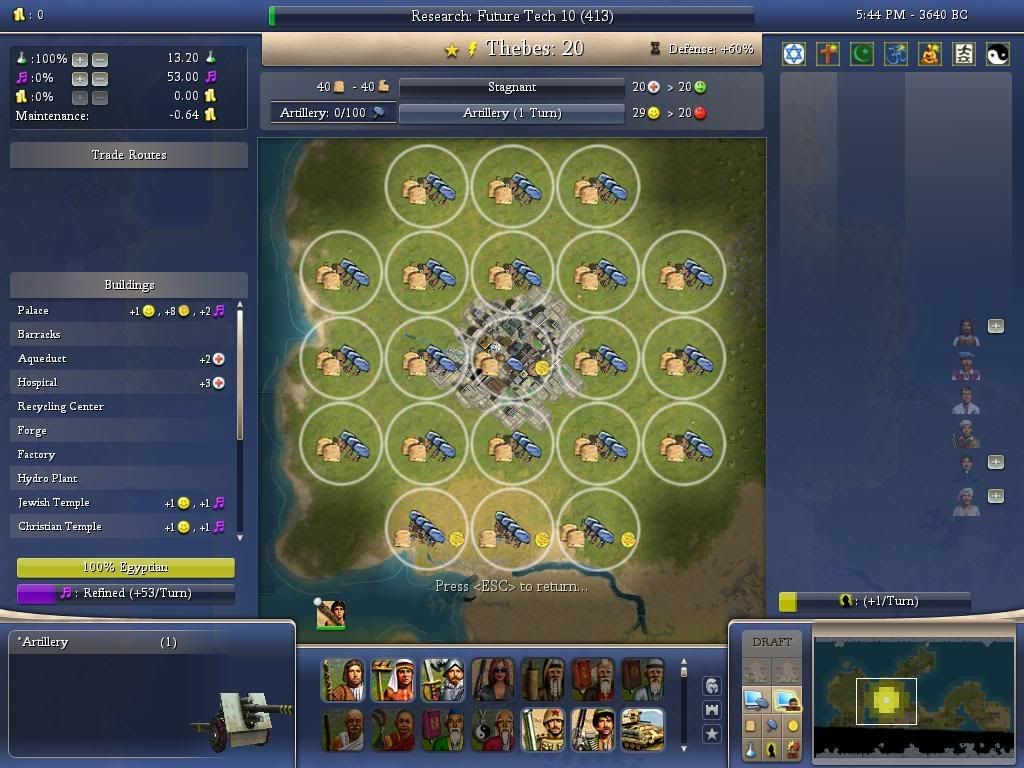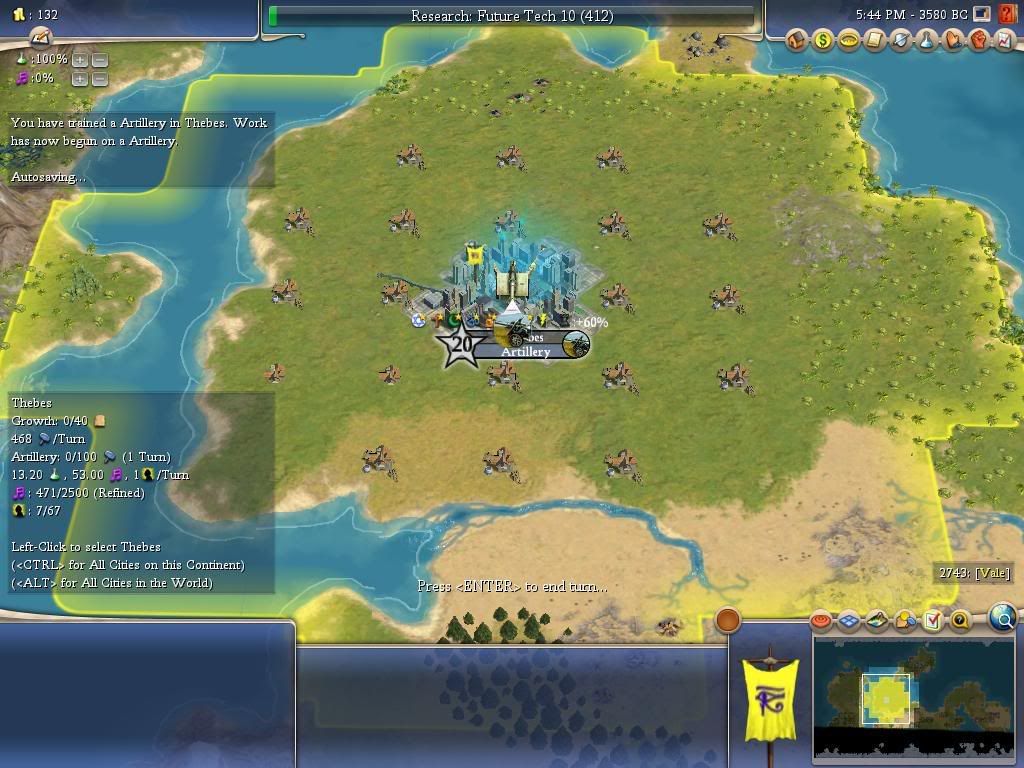vale
Mathematician
Hammer Overflow
Introduction
In this article, I will explain what happens between turns to the excess from a completed build. After that I will examine some potentially uses of overflow to gain some advantages. Throughout the article, any numbers I quote are from the marathon game speed but can be scaled appropriately to your game speed of choice. As of the most recent patch, the way gold overflow works has been slightly changed. The numbers in the original article are still valid for Warlords 2.08. I will update to reflect the BTS changes as I expect them to be based on the patch notes. When I get to try out the patch I will confirm that this is correct. I still have not been able to test this in 3.19 but from all information I have, early game gold overflow does not exist.
from a completed build. After that I will examine some potentially uses of overflow to gain some advantages. Throughout the article, any numbers I quote are from the marathon game speed but can be scaled appropriately to your game speed of choice. As of the most recent patch, the way gold overflow works has been slightly changed. The numbers in the original article are still valid for Warlords 2.08. I will update to reflect the BTS changes as I expect them to be based on the patch notes. When I get to try out the patch I will confirm that this is correct. I still have not been able to test this in 3.19 but from all information I have, early game gold overflow does not exist.
Definitions:
True Cost - The actual cost of a build
cost of a build
Production Multiplier - The production bonus applied to a build converted from a percent + 1
Base Production Multiplier - The production bonus in the city that is applied to any build that city makes + 1.
Base Cost - True Cost/Production Multiplier
Excess Hammers - at the completion of a build in a city, the total number of invested minus the True Cost
invested minus the True Cost
Base Hammers - Excess Hammers/Production Multiplier
Hammers per Turn - the number of produced in a city each turn before any production bonuses
produced in a city each turn before any production bonuses
Modified Hammers per Turn - the number of produced in a city each turn for a build including production bonuses
produced in a city each turn for a build including production bonuses
Overflow Hammers - the number of that are carried over the turn after a build is completed in a city (how to calculate is below)
that are carried over the turn after a build is completed in a city (how to calculate is below)
Overflow Gold - the amount of added to the treasury as a result of overflow (how to calculate is below)
added to the treasury as a result of overflow (how to calculate is below)
The Mechanics of Overflow
At the completion of a production project in a city, if the Base Hammers value does not exceed both the Base Cost and the Hammers per Turn values, then the Overflow Hammers = Base Hammers. This is what happens most of the time.
However, if the Base Hammers exceeds both the Base Cost and the Hammers per Turn values, then the Overflow Hammers = max{Base Cost, Hammers per Turn}. To compensate for the lost , in Warlords 2.08, Overflow Gold = Excess Hammers - max{True Cost, Modified Hammers per Turn} is added to the treasury. In BTS 3.19, the system is quite strange and very unintuitive. I'm not a code guy so I don't really understand exactly what is happening in this post and how the terms there relate to the terms used in my original post.
, in Warlords 2.08, Overflow Gold = Excess Hammers - max{True Cost, Modified Hammers per Turn} is added to the treasury. In BTS 3.19, the system is quite strange and very unintuitive. I'm not a code guy so I don't really understand exactly what is happening in this post and how the terms there relate to the terms used in my original post.
The Wonder Whipping Overflow Trick - still just as relevant in BTS 3.19
Whipping wonders does not convert to
to  at the same rate as whipping normal buildings or units. However, if you whip a building the turn before completion, the Overflow Hammers will be applied to the wonder that follows even though they were created using a more beneficial
at the same rate as whipping normal buildings or units. However, if you whip a building the turn before completion, the Overflow Hammers will be applied to the wonder that follows even though they were created using a more beneficial  to
to  ratio. This is very easy to pull off, just try to ensure that none of your Excess Hammers are being converted to Overflow Gold by whipping only on a building that has a Base Cost somewhat greater than 90
ratio. This is very easy to pull off, just try to ensure that none of your Excess Hammers are being converted to Overflow Gold by whipping only on a building that has a Base Cost somewhat greater than 90  .
.
The Chopping/Whipping Wealth Without Currency Trick - no longer boosted by specific bonuses in BTS 3.19, these will only work in Warlords 2.08
Another possible use is to generate gold by creating an enormous Excess Hammer value. Since production bonuses do apply to the gold generated this way, early double production buildings can be used to create a large amount of gold. Lets do the math on one example:
Say we have an aggressive leader knowing mathematics(not Shaka since his barracks are more expensive) and bronze working, have adopted slavery, and are building a barracks in a city with some available forests, a granary and at least 2 population. We build to within one turn of completion then move it down in the queue and build something else while we chop two forests simultaneously. On the turn that the forests finish chopping, we move the barracks up in the queue and whip it. So
True Cost = 150
Production Multiplier = 1 + 1 = 2
Base Cost = 150/2 = 75
Excess Hammers = [90 (forest chop) + 90 (forest chop) + 90 (whip hammers)]*2(production bonus) + 150 (cost of barracks being covered by "real" production of city) - 150 (True Cost of the Barracks) = 540
Base Hammers = 540/2 = 270
Hammers per turn is unknown but certainly less than 75
Modified Hammers per turn unknown but not relevant because of the above
Overflow Hammers = 75 since 270 > 75
Overflow Gold = 540 - 150 = 390
So, for the cost of chopping two forests and whipping one population we have created an overflow of 75 and 390
and 390  .
.
Introduction
In this article, I will explain what happens between turns to the excess
 from a completed build. After that I will examine some potentially uses of overflow to gain some advantages. Throughout the article, any numbers I quote are from the marathon game speed but can be scaled appropriately to your game speed of choice. As of the most recent patch, the way gold overflow works has been slightly changed. The numbers in the original article are still valid for Warlords 2.08. I will update to reflect the BTS changes as I expect them to be based on the patch notes. When I get to try out the patch I will confirm that this is correct. I still have not been able to test this in 3.19 but from all information I have, early game gold overflow does not exist.
from a completed build. After that I will examine some potentially uses of overflow to gain some advantages. Throughout the article, any numbers I quote are from the marathon game speed but can be scaled appropriately to your game speed of choice. As of the most recent patch, the way gold overflow works has been slightly changed. The numbers in the original article are still valid for Warlords 2.08. I will update to reflect the BTS changes as I expect them to be based on the patch notes. When I get to try out the patch I will confirm that this is correct. I still have not been able to test this in 3.19 but from all information I have, early game gold overflow does not exist.Definitions:
True Cost - The actual
 cost of a build
cost of a buildProduction Multiplier - The production bonus applied to a build converted from a percent + 1
Base Production Multiplier - The production bonus in the city that is applied to any build that city makes + 1.
Base Cost - True Cost/Production Multiplier
Excess Hammers - at the completion of a build in a city, the total number of
 invested minus the True Cost
invested minus the True CostBase Hammers - Excess Hammers/Production Multiplier
Hammers per Turn - the number of
 produced in a city each turn before any production bonuses
produced in a city each turn before any production bonusesModified Hammers per Turn - the number of
 produced in a city each turn for a build including production bonuses
produced in a city each turn for a build including production bonusesOverflow Hammers - the number of
 that are carried over the turn after a build is completed in a city (how to calculate is below)
that are carried over the turn after a build is completed in a city (how to calculate is below)Overflow Gold - the amount of
 added to the treasury as a result of overflow (how to calculate is below)
added to the treasury as a result of overflow (how to calculate is below)The Mechanics of Overflow
At the completion of a production project in a city, if the Base Hammers value does not exceed both the Base Cost and the Hammers per Turn values, then the Overflow Hammers = Base Hammers. This is what happens most of the time.
However, if the Base Hammers exceeds both the Base Cost and the Hammers per Turn values, then the Overflow Hammers = max{Base Cost, Hammers per Turn}. To compensate for the lost
 , in Warlords 2.08, Overflow Gold = Excess Hammers - max{True Cost, Modified Hammers per Turn} is added to the treasury. In BTS 3.19, the system is quite strange and very unintuitive. I'm not a code guy so I don't really understand exactly what is happening in this post and how the terms there relate to the terms used in my original post.
, in Warlords 2.08, Overflow Gold = Excess Hammers - max{True Cost, Modified Hammers per Turn} is added to the treasury. In BTS 3.19, the system is quite strange and very unintuitive. I'm not a code guy so I don't really understand exactly what is happening in this post and how the terms there relate to the terms used in my original post. The Wonder Whipping Overflow Trick - still just as relevant in BTS 3.19
Whipping wonders does not convert
 to
to  at the same rate as whipping normal buildings or units. However, if you whip a building the turn before completion, the Overflow Hammers will be applied to the wonder that follows even though they were created using a more beneficial
at the same rate as whipping normal buildings or units. However, if you whip a building the turn before completion, the Overflow Hammers will be applied to the wonder that follows even though they were created using a more beneficial  to
to  ratio. This is very easy to pull off, just try to ensure that none of your Excess Hammers are being converted to Overflow Gold by whipping only on a building that has a Base Cost somewhat greater than 90
ratio. This is very easy to pull off, just try to ensure that none of your Excess Hammers are being converted to Overflow Gold by whipping only on a building that has a Base Cost somewhat greater than 90  .
.The Chopping/Whipping Wealth Without Currency Trick - no longer boosted by specific bonuses in BTS 3.19, these will only work in Warlords 2.08
Another possible use is to generate gold by creating an enormous Excess Hammer value. Since production bonuses do apply to the gold generated this way, early double production buildings can be used to create a large amount of gold. Lets do the math on one example:
Say we have an aggressive leader knowing mathematics(not Shaka since his barracks are more expensive) and bronze working, have adopted slavery, and are building a barracks in a city with some available forests, a granary and at least 2 population. We build to within one turn of completion then move it down in the queue and build something else while we chop two forests simultaneously. On the turn that the forests finish chopping, we move the barracks up in the queue and whip it. So
True Cost = 150
Production Multiplier = 1 + 1 = 2
Base Cost = 150/2 = 75
Excess Hammers = [90 (forest chop) + 90 (forest chop) + 90 (whip hammers)]*2(production bonus) + 150 (cost of barracks being covered by "real" production of city) - 150 (True Cost of the Barracks) = 540
Base Hammers = 540/2 = 270
Hammers per turn is unknown but certainly less than 75
Modified Hammers per turn unknown but not relevant because of the above
Overflow Hammers = 75 since 270 > 75
Overflow Gold = 540 - 150 = 390
So, for the cost of chopping two forests and whipping one population we have created an overflow of 75
 and 390
and 390  .
.
 . Lets redo the above math, but this time we will be using walls with a protective leader and access to stone.
. Lets redo the above math, but this time we will be using walls with a protective leader and access to stone.

